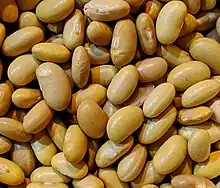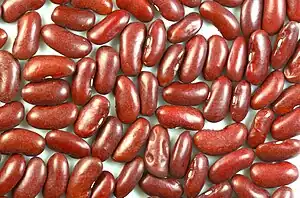papu
See also: papú
Catalan
Further reading
- “papu” in Diccionari de la llengua catalana, segona edició, Institut d’Estudis Catalans.
- “papu”, in Gran Diccionari de la Llengua Catalana, Grup Enciclopèdia Catalana, 2024
- “papu” in Diccionari català-valencià-balear, Antoni Maria Alcover and Francesc de Borja Moll, 1962.
Finnish

Etymology
From Proto-Finnic *papu, borrowed from Proto-Slavic *bobъ.
Pronunciation
- IPA(key): /ˈpɑpu/, [ˈpɑ̝pu]
- Rhymes: -ɑpu
- Syllabification(key): pa‧pu
Noun
papu
- bean (edible seed or pod of plants of several genera of Fabaceae)
- bean (similar seed of some other plants, e.g. coffee)
- Ellipsis of tarhapapu (“common bean”) (plant Phaseolus vulgaris)
- (informal) muscle, especially the biceps
Declension
| Inflection of papu (Kotus type 1*E/valo, p-v gradation) | ||||
|---|---|---|---|---|
| nominative | papu | pavut | ||
| genitive | pavun | papujen | ||
| partitive | papua | papuja | ||
| illative | papuun | papuihin | ||
| singular | plural | |||
| nominative | papu | pavut | ||
| accusative | nom. | papu | pavut | |
| gen. | pavun | |||
| genitive | pavun | papujen | ||
| partitive | papua | papuja | ||
| inessive | pavussa | pavuissa | ||
| elative | pavusta | pavuista | ||
| illative | papuun | papuihin | ||
| adessive | pavulla | pavuilla | ||
| ablative | pavulta | pavuilta | ||
| allative | pavulle | pavuille | ||
| essive | papuna | papuina | ||
| translative | pavuksi | pavuiksi | ||
| abessive | pavutta | pavuitta | ||
| instructive | — | pavuin | ||
| comitative | See the possessive forms below. | |||
| Possessive forms of papu (Kotus type 1*E/valo, p-v gradation) | ||||||||||||||||||||||||||||||||||||||||||||||||||||||||||||||||||||||||||||||||||||||||||||||||||||||||||||||||||||||||||||||||||||||||||||||||||||||||||||||||||||||||||||||||||||||||||||||||||||||||||||||||||||||||||||||||||||||||||||||||||||||||||||||||||||||||||||||||||||||||||||||||||||||||||||||||||||||||||||||||||||||||||||||||||||||||||||||
|---|---|---|---|---|---|---|---|---|---|---|---|---|---|---|---|---|---|---|---|---|---|---|---|---|---|---|---|---|---|---|---|---|---|---|---|---|---|---|---|---|---|---|---|---|---|---|---|---|---|---|---|---|---|---|---|---|---|---|---|---|---|---|---|---|---|---|---|---|---|---|---|---|---|---|---|---|---|---|---|---|---|---|---|---|---|---|---|---|---|---|---|---|---|---|---|---|---|---|---|---|---|---|---|---|---|---|---|---|---|---|---|---|---|---|---|---|---|---|---|---|---|---|---|---|---|---|---|---|---|---|---|---|---|---|---|---|---|---|---|---|---|---|---|---|---|---|---|---|---|---|---|---|---|---|---|---|---|---|---|---|---|---|---|---|---|---|---|---|---|---|---|---|---|---|---|---|---|---|---|---|---|---|---|---|---|---|---|---|---|---|---|---|---|---|---|---|---|---|---|---|---|---|---|---|---|---|---|---|---|---|---|---|---|---|---|---|---|---|---|---|---|---|---|---|---|---|---|---|---|---|---|---|---|---|---|---|---|---|---|---|---|---|---|---|---|---|---|---|---|---|---|---|---|---|---|---|---|---|---|---|---|---|---|---|---|---|---|---|---|---|---|---|---|---|---|---|---|---|---|---|---|---|---|---|---|---|---|---|---|---|---|---|---|---|---|---|---|---|---|---|---|---|---|---|---|---|---|---|---|---|---|---|---|---|---|---|---|---|---|---|---|---|---|---|---|---|---|---|---|---|---|---|---|---|---|---|---|---|---|---|---|---|---|---|---|---|---|---|---|---|
| ||||||||||||||||||||||||||||||||||||||||||||||||||||||||||||||||||||||||||||||||||||||||||||||||||||||||||||||||||||||||||||||||||||||||||||||||||||||||||||||||||||||||||||||||||||||||||||||||||||||||||||||||||||||||||||||||||||||||||||||||||||||||||||||||||||||||||||||||||||||||||||||||||||||||||||||||||||||||||||||||||||||||||||||||||||||||||||||
Derived terms
- adsukipapu
- hyppypapu
- härkäpapu
- kaakaopapu
- kahvinpapu
- kahvipapu
- kidneypapu
- kikpapu
- lehmänpapu
- leikkopapu
- mungpapu
- mustapapu
- mustasilmäpapu
- papukeitto
- Papunen
- papupata
- papurokka
- papusoppa
- pavunvarsi
- pensaspapu
- pintopapu
- pitkäpapu
- punapapu
- risiinipapu
- ruusupapu
- salkopapu
- siipipapu
- soijapapu
- taitepapu
- tarhapapu
- uunipavut
- vahapapu
- valkoinen papu
- vihreä papu
Further reading
- “papu”, in Kielitoimiston sanakirja [Dictionary of Contemporary Finnish] (in Finnish) (online dictionary, continuously updated), Kotimaisten kielten keskuksen verkkojulkaisuja 35, Helsinki: Kotimaisten kielten tutkimuskeskus (Institute for the Languages of Finland), 2004–, retrieved 2023-07-03
Ingrian
Alternative forms
Pronunciation
- (Ala-Laukaa) IPA(key): /ˈpɑpu/, [ˈpɑpu]
- (Soikkola) IPA(key): /ˈpɑpu/, [ˈpɑb̥u]
- Rhymes: -ɑpu
- Hyphenation: pa‧pu
Declension
| Declension of papu (type 4/koivu, p-v gradation, gemination) | ||
|---|---|---|
| singular | plural | |
| nominative | papu | pavut |
| genitive | pavun | pappuin, papuloin |
| partitive | pappua | papuja, papuloja |
| illative | pappuu | pappui, papuloihe |
| inessive | pavus | pavuis, papulois |
| elative | pavust | pavuist, papuloist |
| allative | pavulle | pavuille, papuloille |
| adessive | pavul | pavuil, papuloil |
| ablative | pavult | pavuilt, papuloilt |
| translative | pavuks | pavuiks, papuloiks |
| essive | papunna, pappuun | papuinna, papuloinna, pappuin, papuloin |
| exessive1) | papunt | papuint, papuloint |
| 1) obsolete *) the accusative corresponds with either the genitive (sg) or nominative (pl) **) the comitative is formed by adding the suffix -ka? or -kä? to the genitive. | ||
Derived terms
Etymology 2

Pojil tiuketaa pappua (1).
Borrowed from Russian бабки (babki), perhaps influenced by Etymology 1 due to knucklebones' resemblance to beans.
Pronunciation
- (Ala-Laukaa) IPA(key): /ˈpɑpu/, [ˈpɑpu]
- (Soikkola) IPA(key): /ˈpɑpu/, [ˈpɑb̥u]
- Rhymes: -ɑpu
- Hyphenation: pa‧pu
Noun
papu
- knucklebones: a traditional game, in which ten knucklebones are set in a row and players try to topple them by throwing another bone against them from a distance.
- knucklebone (used in a game of knucklebones)
Declension
| Declension of papu (type 4/koivu, no gradation, gemination) | ||
|---|---|---|
| singular | plural | |
| nominative | papu | paput |
| genitive | papun | pappuin, papuloin |
| partitive | pappua | papuja, papuloja |
| illative | pappuu | pappui, papuloihe |
| inessive | papus | papuis, papulois |
| elative | papust | papuist, papuloist |
| allative | papulle | papuille, papuloille |
| adessive | papul | papuil, papuloil |
| ablative | papult | papuilt, papuloilt |
| translative | papuks | papuiks, papuloiks |
| essive | papunna, pappuun | papuinna, papuloinna, pappuin, papuloin |
| exessive1) | papunt | papuint, papuloint |
| 1) obsolete *) the accusative corresponds with either the genitive (sg) or nominative (pl) **) the comitative is formed by adding the suffix -ka? or -kä? to the genitive. | ||
References
- Ruben E. Nirvi (1971) Inkeroismurteiden Sanakirja, Helsinki: Suomalais-Ugrilainen Seura, page 369
Lower Sorbian
Pronunciation
- IPA(key): [ˈpapu]
Polish
Etymology
Perhaps from papa (“glop, mush, pap”). Compare Latin pāpa, pappa, English pap, Hungarian papi.
Pronunciation
- IPA(key): /ˈpa.pu/
Audio (file) - Rhymes: -apu
- Syllabification: pa‧pu
Spanish
Etymology
Probably from papi or back-formation from papucho. Originated on Spanish-speaking Facebook group La Grasa in early 2010s, usually to describe its male members.
Pronunciation
- IPA(key): /ˈpapu/ [ˈpa.pu]
- Rhymes: -apu
- Syllabification: pa‧pu
Coordinate terms
Unami
Etymology
(This etymology is missing or incomplete. Please add to it, or discuss it at the Etymology scriptorium.)
Verb
papu (animate intransitive)
- (animate, intransitive) he/she plays
present indicative conjugation of papu
| papi | |
|---|---|
| 1st person singular | mpapi |
| 2nd person singular | kpapi |
| 3rd person singular | papu |
| 1st person plural inclusive | mpapihëna |
| 1st person plural exclusive | kpapihëna |
| 2nd person plural | kpapihëmo |
| 3rd person plural | papiyòk |
Related terms
References
- Rementer, Jim with Pearson, Bruce L. (2005) “papu”, in Leneaux, Grant, Whritenour, Raymond, editors, The Lenape Talking Dictionary, The Lenape Language Preservation Project
West Makian
Pronunciation
- IPA(key): /pa.ˈpu/
This article is issued from Wiktionary. The text is licensed under Creative Commons - Attribution - Sharealike. Additional terms may apply for the media files.
